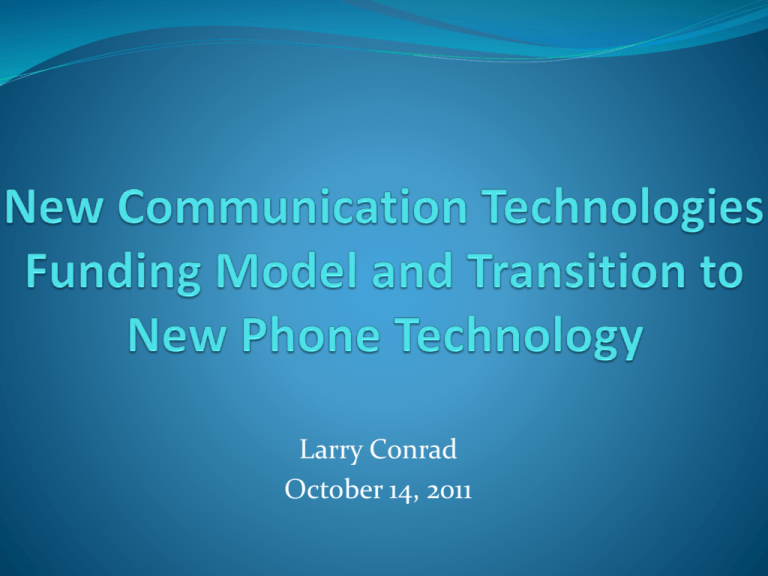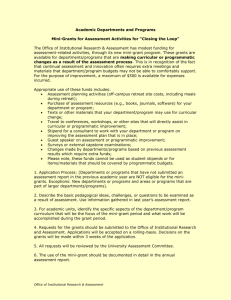New Communication Technologies Funding Model and Transition to
advertisement

Larry Conrad October 14, 2011 Issues with Current Comm Tech Funding Model Based on phone service only…no networking charges Revenues generated from bundled voice/data charge Phone cost = $48.00/month…by comparison the NCSU cost for a phone is $8.00 per month Drives departments to remove phones, convert to cell phones or Skype…which is a loss of network infrastructure funding…but network use increases The entire cost is on department operating budgets No funding for student use (except in residence halls) No funding from UNC Hospitals No funding for capital refresh or network expansion Issues with Current Phone Service Long term contract with AT&T expired the end of March, 2011 That contract had punitive language governing removal of phone lines Have transitioned to the State of NC ITS AT&T contract for the duration of the migration to VoIP which allows us to ramp down without penalty Telephone technology has progressed to provide a viable and cost-effective data network based solution: Voice-over-IP (VoIP) Have signed an agreement with Verizon to transition to a VoIP solution over the next two years Baseline Services--Redefined Core services – included in network infrastructure charge Wired connections Wireless connections Off-campus wireless connections VLANs and ACLs Access control Installing fiber and copper IP address assignment Domain name service NTP services Monitoring and addressing abnormal network activity A-la-Carte Services--Redefined Optional services – charged on an a-la-carte basis Telephones and related services Off-campus wired connection Wireless refresh in advance of schedule Restricted VPN use Microwave transport Dedicated alarm lines Dark fiber and T1 MetroEthernet Cable tv Point-to-point video transport Process to Allocate Cost Need to provide $11.3 million/year for Core (network) Principles Charge on the basis of a % of total salaries Use by all member of the campus community – faculty, staff, students – should be paid for on an equitable basis Basic charge applicable to all users, with additional charges to special sub-groups Pie must be expanded, with no dramatic increases to departments in this budget environment Expansion ideally means new sources of revenue for departments as well as sources of revenue beyond departments A-la-carte services will pay for themselves % of Payroll Enlarges the Pie Charges to salary source, so direct charge to contracts and grants Historically, grants not charged Historically not in F&A rate base either $1.4 million reallocated to contracts and grants by this rate model based on current salary distributions Office of Research found other institutions directly charging contracts and grants for this Request to be allowed to direct charge contracts and grants has been submitted by the Office of Research Funding Model Summary Departments – 0.54% x payroll Student fee – 0.54% x cost to educate 1/3 to 1/2 from reallocated or increased (E&)T fee Remainder from central University sources ResNet (Housing) – direct cost + overhead Affiliated entities (e.g., UNC Healthcare and GA) – as negotiated with each Building operating reserve – as appropriated by Legislature Capital project fee (non-recurring) – as charged to projects Estimated Recurring Revenue Stream Departmental funding Student funding ResNet Affiliated entities (estimate) Building operating reserve Total $ 6,500,000 $ 3,100,000 $ 433,337 $ 100,000 $ 801,106 $ 10,934,443 Transition Plan 2011-12 ITS produce a pro forma invoice for the new funding model and an actual invoice for the current model each month for every department Same practice as when other utility rate models change Allows orderly reallocation of funds among departments by Deans and/or Vice Chancellors Student E&T fee decision processed through student fee process that begins in August 2011 for the 2012-13 year VoIP Implementation defined and coordinated 2012-13 Implementation “Bottom Line” Phone line charge drops from $48/mo to $14.50/mo “Baseline” services are for the network, not the phone VoIP transition will begin this fall and is targeted for completion within two years New funding model will be effective July 1, 2012 Pro-forma billing will begin this fall for the new funding model to give units information about their future billings QUESTIONS?






